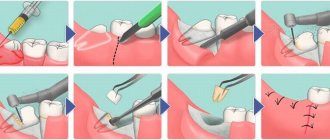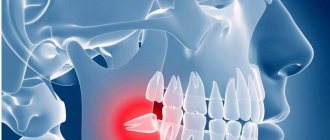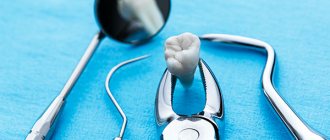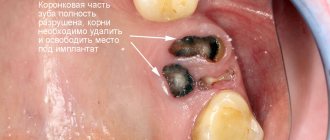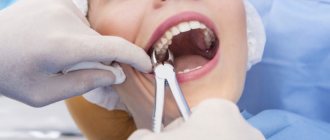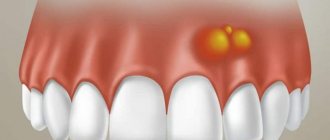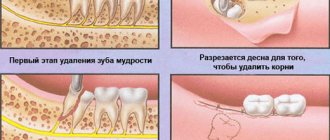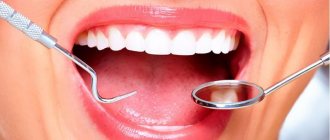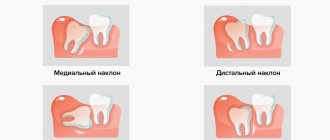Where is a person's wisdom tooth located?
Many people know that this tooth is also called a rudiment, figure eight or 3rd molar.
The name “eight” speaks for itself, since this tooth completes the dentition and is the eighth in a row. There is virtually no benefit to these teeth; they are considered ordinary molars. Formation occurs before the age of 8 and only at the age of 20 do they begin to emerge. The name wisdom teeth was invented back in the old days, because their eruption is equated to the age of maturity in physical and mental terms.
As a rule, the eruption of wisdom teeth is accompanied by pain and discomfort, and in some cases, abnormalities. The latter require surgical intervention.
Reasons for removing wisdom teeth
Oddly enough, 20% of people visiting a dental clinic want to voluntarily get rid of their wisdom teeth, although there is no reason at all for their removal. The answer to the question why they do this is quite simple. It all lies in the fear of future problems.
All other people go to the clinic for real reasons:
1. The wisdom tooth is poorly positioned and does not allow full oral care. This problem must be resolved, since food particles in the teeth can subsequently provoke the appearance of various bacteria, bad breath, tartar buildup and plaque. If pain is felt, treatment will be difficult. 2. Dystopia (crooked wisdom tooth). In this case, you need to be extremely careful, since neighboring ones can be displaced, the roots can be damaged, and the gum tissue can be injured. This phenomenon will lead to inflammatory processes in the soft tissues, as well as pericoronitis, resulting in the formation of an abscess. 3. The tooth does not erupt. Infections develop that lead to the appearance of caries, tartar, and discomfort when clenching the jaws and during chewing. Nearby teeth are damaged.
When should a wisdom tooth be removed?
In any case, an experienced specialist will ask what is the reason for visiting the clinic and what caused the decision to remove the wisdom tooth. You need to discuss all the sensations with your doctor: the nature of the pain, what sensations are present. The more the specialist knows about the patient’s sensations, the easier it will be for him to carry out surgical procedures.
There are no age restrictions for the procedure for removing the rudiment, so you need to put aside all your fears and go to the dentist. Pay attention to various pains in your mouth and fix the problem as soon as it appears. In this way, unpleasant problems can be prevented.
How does the deletion work?
There are cases when patients want to remove a wisdom tooth without clear prerequisites for the operation. Is it possible. Some dentists support this decision due to the fact that in the area where the figure eights are located, it is very difficult for a person to brush their teeth, so food debris accumulates there, forming a stone, and then caries begins, which, without treatment, can lead to tooth loss. Therefore, doctors immediately remove it. The procedure is performed by a surgeon as it is a major operation.
Wisdom teeth do not erupt
You should contact the dentist even if the molar does not cause discomfort. It can remain in this state for up to a certain time, since dental roots grow quickly, and over time they will interfere with the neighbor’s teeth. If a tooth remains in the gum for a long time, then it is a serious provocateur of caries and decay. This arrangement of the rudiment causes injury to soft tissues, resulting in periodontitis, periodontal disease and other unpleasant diseases.
How to understand that you need to remove the figure eight hood
- Doctors insist on surgical treatment if:
- pus accumulates between the molar and gum;
- the pain is so severe that it is even difficult for a person to talk;
- signs of acute gingivitis appear, surrounding tissues are included in the pathological process;
- pain radiates to the temple, neck, lymph nodes;
- body temperature often rises.
All these symptoms indicate that the inflammation is very strong and measures need to be taken as soon as possible to eliminate it.
We remove a wisdom tooth that is not growing properly
The rudiment, compared to other teeth, grows later than all others, so there is not enough space for its growth and the arrangement of neighboring teeth changes, they begin to bend.
In any case, a crooked molar can cause injury to soft tissues, which causes blood and wounds on the gums. If pieces of food remain after eating food, there is a risk of infection.
The worst thing is dystopia, since food not only gets into the soft tissues, but also remains in the interdental space. In this case, the teeth are destroyed as the process of decay begins.
When can I do a simple removal?
1. The rudiment has a root system, like other teeth. 2. Most of the tooth is intact. 3. The third molar is not susceptible to caries damage and tartar. 4. Its location is correct and the doctor can easily reach it.
At the clinic, the patient is seated on a dental chair and the oral cavity is examined. An injection produces pain relief. Small incisions are made, and if necessary, the tooth is ground down. Using a special dental instrument, the specialist pries up the root of the third molar and extracts it. Afterwards disinfection is carried out and the bleeding stops. An anesthetic is placed in the place where the tooth grew and anti-inflammatory drugs are prescribed. The patient can return for a re-examination in a week.
Complex wisdom tooth removal
If we talk about complex operations, the leader is the extraction of an impacted tooth that is not able to erupt on its own. Such manipulation is carried out by a highly qualified dental surgeon.
Anesthesia (local) is prepared for the patient. Then the mucous membrane is cut so that it is convenient to get to the roots. In case of a deep tooth location, the doctor cuts out a flap located above the bones. All this also occurs on the mucous membrane, and the cutout resembles the shape of a triangle. Afterwards, holes are made in the jaw to remove the tooth. For such a procedure you will need a drill or ultrasound equipment. Use forceps to remove the figure eight. In case of large sizes, the tooth is removed in parts. An anesthetic is placed in that cavity, which is now empty. And they stitch up the places where the incisions were. Anti-inflammatory drugs are prescribed and are part of complex therapy.
Surgical intervention is also carried out in a similar way when the wisdom tooth is positioned incorrectly. The most complex manipulations include the removal of a tooth where part of the crown has collapsed. Forceps will no longer help here, so specialists use special instruments (surgical, dental). Initially, a flap located in the gum is cut out, after which the part of the figure eight that has been destroyed is removed. Boron is used for this.
If a tooth is cracked, pieces may come loose. In such situations, they are removed from the gums during the intervention. The next month after such an operation, the patient must visit the doctor according to the schedule. The dynamics of recovery will be observed here. And based on this dynamics, individual treatment is selected that is necessary after the operation.
Extraction on the upper jaw
Is it painful to remove a wisdom tooth from above? There is less pain here, so the procedure is faster. This point can be explained by the fact that the upper jaw has its own structural characteristics. Bone density is less, it is characterized by plasticity. There is no curvature of the root; its growth is in the right direction. Nothing interferes with surgical intervention.
To extract a wisdom tooth, forceps or an elevator are used. However, there is a risk that the root will break. To avoid such a development of events, it is better to take an x-ray.
Is it painful to remove a wisdom tooth?
This is not to say that during such manipulation there will be no sensation of pain. Initially, local anesthesia is administered, but the patient will still feel discomfort and mild pain. Why? The wisdom tooth has a root system that is distinguished by its power. And when it is removed, not very pleasant sensations arise.
Don't use too much painkiller. After the anesthesia wears off, you will feel unwell and in pain. These sensations will continue for several more days. The discomfort will disappear after the stitches heal.
Extraction on the lower jaw
Many people have a question: is it painful to remove a wisdom tooth from below? Surgery on the lower jaw is quite difficult, since the bone is more dense. This causes more pressure to be applied to the molar and the roots begin to grow incorrectly. This does not allow the patient to open his mouth normally, because this becomes very painful. Due to the fact that the doctor cannot clearly examine the oral cavity, the process becomes difficult. But, in order to get to the gum, you need to cut it.
Healing after wisdom tooth removal
After removing the figure eight, blood clots begin to form in the hole. It takes up to two days for them to form. Afterwards, the empty space is filled with granulation tissue, resulting in epithelium. The hole is fully healed after a month.
If infection occurs during surgery, the wound will take longer to heal. If the incisions were sutured using regular threads, then a week after surgery the doctor should remove them. If the removal is careless, this will also delay the healing process. Bone tissue, its formation takes 2-6 months.
Recommendations after wisdom tooth removal
The doctor is obliged to conduct a consultation with the patient and tell him how to behave after the operation. If you follow all the recommendations, healing will be quite fast. Otherwise, the process will be delayed, and unpleasant consequences may occur:
- — after the manipulation, you should not eat or drink for 2 hours;
- - during the next 24 hours after the intervention, you should not eat cold, hot or hard foods;
- - do not rinse vigorously;
- — it is not recommended to warm the cheek on the side where the tooth was removed;
- — visiting the sauna and bathhouse is prohibited, do not take a hot bath;
- - You can’t brush your teeth during the day;
- - try not to take food to the side where the molar was removed, do not chew;
- - It is not recommended to touch a hole that is empty with your tongue, various parts or fingers.
Rehabilitation period
How long it will take for your gums to recover depends on many factors:
- volume of tissue removed;
- client age;
- individual characteristics of the patient’s body;
- correctness of the operation;
- accuracy of patient compliance with medical prescriptions.
To make rehabilitation as simple and fast as possible, you need to remember the rules:
- Do not eat for three hours after completion of surgical treatment.
- Remove the turunda (compress) only when the doctor tells you to. However, it should not be in the mouth for more than a day.
- Do not chew food on the same side of the jaw on which surgery was performed.
- Do not eat hot or very cold foods. The same goes for drinks.
- During hygiene procedures, do not touch the wound with a brush.
- Strictly take all medications prescribed by the dental surgeon.
- Do not self-medicate (it is unacceptable to try to speed up recovery using dubious folk methods).
If the patient listens to the advice of his doctor, the wound will heal quite quickly.
Complications after wisdom tooth removal
In some cases, complications may arise after removing the rudiment. Here the culprit may be the circumstances that have developed, the patient or the medical worker. But in most cases, complications are caused by neglect of advice after the procedure.
Complications:
- - the roots of the teeth that are located nearby are injured;
- - infection develops;
- - gums become swollen;
- - tongue and lips become numb. This occurs due to the fact that the tooth is close to the nerves;
- - dry socket syndrome;
- - alveolitis develops.
There is no longer a need for 3 molars. According to scientists, after 200 years people will not know what the rudiment is. In the meantime, you should monitor your oral cavity and its state of health in more detail. If you suspect a small problem, don't delay. Contact your dentist immediately.
